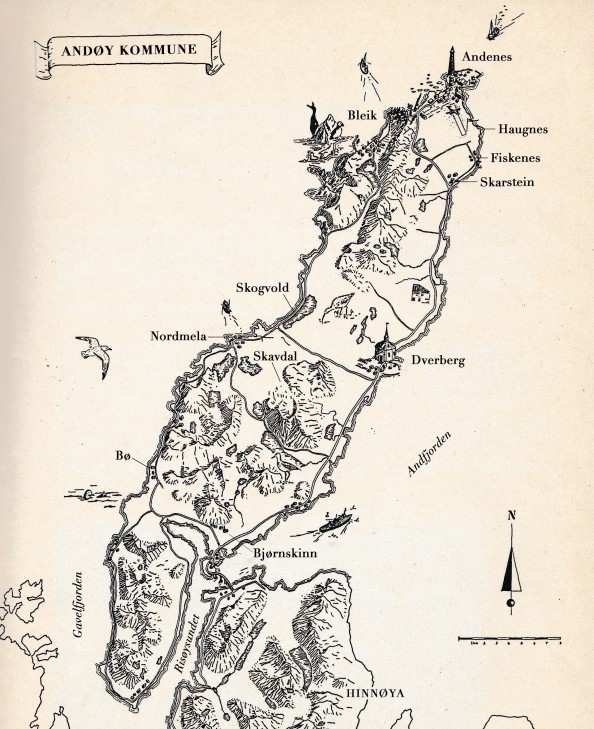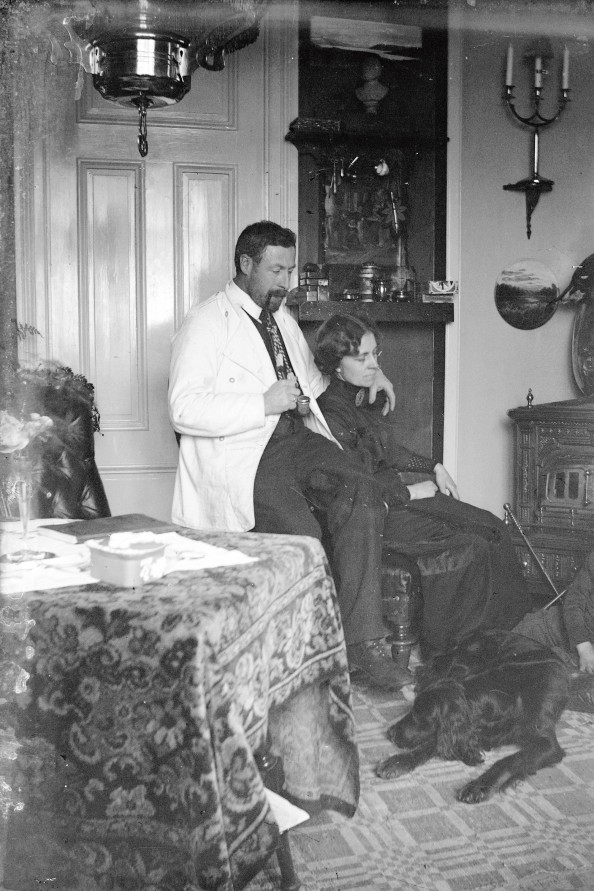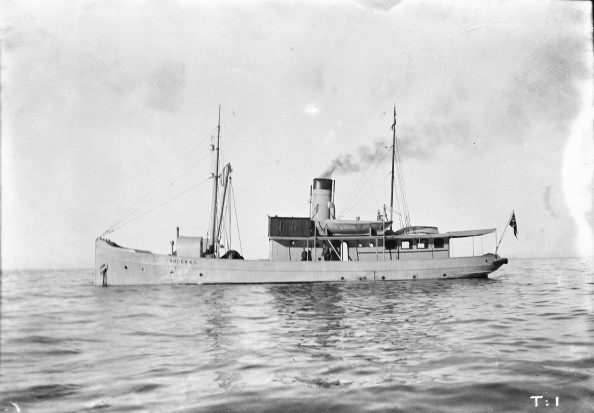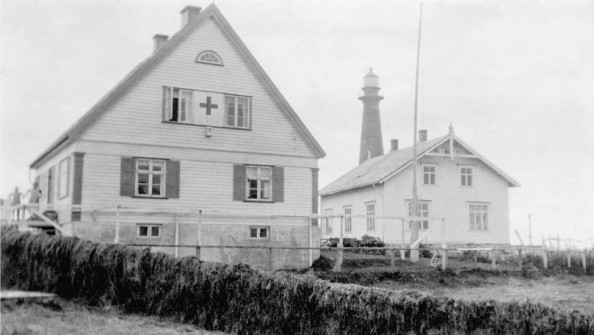In July 1918, the Spanish flu came to Andøya island. The municipal medical officer, Christian Fredrik Rossow, wrote an account of his experience of the epidemic. His descriptions have clear similarities with the current COVID-19 epidemic.

Map of Andøy municipality. Illustration: Trond Kanstad, adapted by the Journal of the Norwegian Medical Association
The World Health Organization is now describing the COVID-19 epidemic as a pandemic (1). It has been compared to the Spanish flu (1918–19) and other major viral pandemics in the 20th and 21st centuries (2). Isolation of the infected and ill as measures to stop the infection from spreading were as relevant then as they are now (3, 4).
The municipal medical officer
During the outbreak of the Spanish flu, Christian Fredrik Rossow (1871–1948), my great-grandfather, served as chief municipal medical officer at Andenes in Andøya municipality. He worked there as medical officer for twelve years from 1912, and left a handwritten book (5) dedicated to his wife, the painter Dagny Rossow (1873–1953). She also played an active role during this epidemic. They themselves both fell ill from the infection.
His eyewitness account provides a description of the events as they unfolded. The encounter with the pandemic at the time spurred the establishment of a local Red Cross association (1919) and construction of a clinic at Andenes (1923) to take care of the ill. The association celebrated its centennial in August 2019.

Christian Fredrik and Dagny Rossow, Andenes, around 1918. Photo: Magdalene Norman/Sør-Troms Museum
There came a ship …
The Spanish flu came to Andenes from Harstad with the local steamer, the D/S Andenæs VDS (belonging to the Vesteraalens Dampskibsselskab shipping company) on 21 July 1918. The next day, the first reports of cases came in. These patients had been on board during the port call (6).
Rossow wrote the following about his encounter with the epidemic (my additions/comments in brackets):
‘In the summer of 1918 the Spanish flu started to spread up north. We had already heard about its ravages further south, and were hoping to steer clear of it as far as possible, living so far out in the sticks as we were. One day, however, I received a telegram requesting me to come aboard the D/S Andenæs, since there were lots of ill people on board. I was to bring medicine with me. I was met by a distressing sight, there were ill people in every cabin – some of them in really poor condition. Three-quarters of the ship’s crew had taken to their beds, so they did not even have enough crewmen. The medicine I had brought with me did not suffice, so more had to be fetched. The captain wanted me to accompany the ship to Harstad, which I did. I returned the next day.
With the D/S Andenæs, Eivind and Bjarne (their sons) also came from Oslo, fortunately they were both well. There was great rejoicing in the family for this reason.
The war (1914–18) was still raging, however, and our neutrality at that time appeared also to be at risk. My council meetings were not scheduled to start until the 3rd of August and last until mid-September, so I spent the best part of the summer at home in Andenes, but I had to be prepared for anything, since things could take a critical turn at any moment.’

D/S Andenæs. Photo: Lofotmuseet-Museum Nord
Infected
‘Time passed, however, and the Spanish disease appeared both here and there. So one day as we – the children and I – were throwing skotthyll (a game similar to ring toss, translator’s note), I was called out to Haugnes, about four kilometres away. I took my bicycle and all was well and good until I came back home. Then I suddenly had chills, followed by sweating so profuse that it was dripping from my face. The children wanted me to continue to throw skotthyll, but I was clearly unable. Both mother (his wife Dagny Rossow) and Mr Kiil (local landowner Jens Anton Kiil, 1847–1930) who saw me standing there on the porch thought that I had cycled too fast, but that was not the case! I realised that I had contracted the Spanish disease, and stood there speculating on what I should do. I asked mother (Dagny) to boil some water and invited Mr Kiil for a toddy. He had to laugh, since it was so hot outside. We had a toddy, however, and I drank 3 large glasses in a row. Then I went upstairs to bed. My temperature was 41 degrees and I was said to have been quite delirious during the night, but the next day my temperature had gone down to 38, and in the evening it was normal. The next day I was back on my feet, so I escaped quite lightly.’
‘Mrs Doctor’
‘A few days later I had to travel to Elvegaardsmoen (a military base in Narvik, where Rossow was the army surgeon), and I stayed there until the 18th of November! A long and arduous period of service. While I was at the military camp, I should have had a locum, but there was no possibility of any such, so we found ourselves in a rather awkward situation when the Spanish disease started its ravages. To be sure, there was a pharmacy where one could obtain the most common medicines, but this was clearly not enough. The local doctor – Dr Krogstad – at Dverberg had promised to keep the surgery open once or twice per week, which was good. Unfortunately he was unable to do this, since the pressure at Dverberg and Bjørnskinn was too much for him. Consequently, it was ‘Mrs Doctor’ (Dagny Rossow) who had to shoulder the heaviest burden by walking around to help the ill, of whom there were many at that time.
The Spanish flu came to Andenes from Harstad with the local steamer
Both fishing huts and homes were full of ill people, and there was no other nurse there. However, “Mrs Doctor” organised the help in consultation with the officers of the Salvation Army and a couple of other women volunteers, and after many difficulties they were thus able to get through this terrible epidemic. There were many deaths as well. (…)
Even “Mrs Doctor” and the maidservant fell ill and had to stay in bed, and things fell so silent at the doctor’s house that the lighthouse-keeper’s wife felt she had to come and ask how things were. She was greatly alarmed when she found them both ill. But she was a wonderful person. She helped them in the best manner by cooking and washing, and nursed them’ (5).
First and second waves – need for isolation
The epidemic came in waves, first in July 1918, with the first case registered on 22 July. After a few days 50–60 people had fallen ill across the entire fishing hamlet. Not until eight days later did the epidemic reach the nearest hamlets of Haugnes, Fiskenes, Skarstein and Bleik. This initial period appeared to pass without any deaths in the local community (6). However, the first deaths occurred already on 16 and 17 August. This happened in Bø, where a 43-year-old woman and her one-year-old daughter died within one day of each other.
Later, in September a more virulent form appeared, causing more deaths. The local Andøyposten newspaper wrote about it on 4 October 1918: ‘The Spanish flu appears even here to be spreading to an ominous degree. Not so many deaths are reported to have occurred here, but quite a lot of people are said to be ill, both here in town (Andenes) and in the hamlets. To date, the board of health has closed the various meeting-houses, and it is not unlikely that the schools will also have to be closed.’
On 11 October 1918, the newspaper writes: ‘The Spanish flu is now raging quite furiously. In virtually every home there is illness, and not a few deaths.’
18 October: ‘The situation regarding the Spanish flu has improved somewhat here in town, but it continues to rage in the hamlets, especially at Bjørnskinn, where many deaths have occurred over a short time, especially among women’ (5).
In October, the board of health banned most public arrangements; exceptions were made only for the schools and ‘regular divine service’. About the fact that the schools were not closed, the local GP Krogstad writes: ‘The fact that the schools were not closed was because there were relatively few cases of the disease in children’. However, on 12 December that year, the school at Andenes was also closed. The school records for that year state: ‘The board of health ordered the school to close by Christmas’ (6).
Lack of healthcare personnel
In some families everyone was ill and needed external help. However, the large number of cases ‘spread out over three parishes’ complicated the task of finding adequate help to nurse the ill. Dagny Rossow, my great-grandmother, therefore placed an advertisement in the Andøyposten newspaper on 22 November 1918 with the following appeal:
’(…) At this time, when disease has struck in nearly every home, there is widespread need for help to nurse and care for those who are ill. If there is someone who out of the kindness of their heart wants to help and alleviate the suffering, they can report to Dr Rossow, who will direct them to where the need is greatest. Have no fear of infection, this should not hold anyone back from extending help to the sick at this terrible time’ (6).
Third wave – a festive Christmas party spreads the infection
In the Christmas period in 1918, the western side of Andøya island was hit by a third wave of infections. On 26 December, a festive Christmas party was held at Nordmela, which virtually all the young people from the hamlets of Nordmela and Skogvold attended, including a son and a maidservant from the Skavdal farm. In his medical report for 1918, local GP Krogstad mentions that people from this farm had not left the farm or received any visitors during the 14 days preceding Christmas. On 28 December the first cases appeared, with high fever and cough. It was found that the son had ‘a cough with sparse, viscous, rust-coloured phlegm’. He was described as having ‘an extensive bronchitis in both lungs; in the maidservant nothing physical could be determined’. The same afternoon, reports came in from Nordmela saying that practically all those who had attended the festive party were now ill (6).
The clinical picture
In light of the outbreak after the festive party, GP Krogstad estimated that the disease had an incubation period of 48 hours. Furthermore, he writes about the symptoms in his medical report for that year:
‘In most patients, the disease appeared quite acutely and as if it had been thrown onto them, and manifested itself in a fairly severe headache, dedolations (muscle pain), back pain, hoarseness, head cold and cough with or without bronchitis, and as a rule, the patient immediately had to go to bed. Often also nosebleed. Generally, the disease lasted for 8–14 days, but the patients often felt listless and enfeebled for several weeks afterwards. Not unusually, bothersome sweats occurred, which could last for 2–3 months after the affected person was able to work again’ (
6
).
The board of health ordered the school to close by Christmas
Krogstad also mentions that the influenza was often accompanied by pneumonia, as well as milder ear infections that receded without treatment. In addition, there were a few cases of gastrointestinal influenza with acute diarrhoea. These often took a mild course and lasted for 3–4 days (6). He also writes that ‘immediately linked to the influenza I have seen four cases of clinically determined pulmonary tuberculosis. Two of these had previously suffered from tbc. Pedis that was healing well, but in connection with the influenza there appeared a rapid, extensive pulmonary tuberculosis. In the other two patients there were no signs of tuberculosis’ (6).

The Red Cross clinic, Andenes. Photo: Sør-Troms Museum
Gone without a trace
Rossow wrote about the end of the epidemic in his report for 1919: ‘It disappeared without a trace as the year 1919 began, in that no more than three cases were reported’ (5). In 1918, there had been 549 reported influenza cases.
He added, though, that ‘there appeared during the first months (of 1919) some cases that I have interpreted as sequelae of this insidious disease, such as debilitation of the heart, nervous afflictions of various kinds, hysteria and melancholia, though all of which of a transient nature’ (5).
Remedies
Then as now, no effective drugs against the disease were available. It is reported that in virtually every house a can of tar was kept on the stove, since the tar fumes were supposed to have both a preventive and an alleviating effect on the Spanish flu. Some also believed in tobacco, and thought that nicotine would do away with the ‘devilment’.
The spread of infection and the recommended measures are strikingly similar when we compare the current pandemic with the Spanish flu 100 years ago
Many also believed that brandy helped cure the disease. Quite extraordinarily, the alcohol prohibition during the First World War, which was made permanent by a decision of the Storting, was repealed by the government due to the Spanish flu. In late autumn 1918 and in response to massive pressure, the liberal government of prime minister Gunnar Knudsen (1848–1928) allowed all households to buy one half-bottle of brandy without a prescription as a one-off measure for treatment of the Spanish flu (‘Mr Løvland’s half-bottle’) (7).
Local mortality
The local GP’s medical report for 1918 states ‘influenza’ as the cause of death in 16 cases. If we assume that the number of reported cases of influenza (549) is correct, this gives a mortality rate of 2.9 %. The church records, however, give the Spanish flu as the cause of death in 24 cases for the same year. A possible explanation for this difference in reported mortality could be that some of those who perished from the Spanish flu and were buried in Andøya had died elsewhere. They may have been brought to their ancestral village and laid to rest there (6). In 1918, the village of Andenes had a population of approximately 1 500, and there were seven registered deaths from the epidemic. The island of Andøya had a total population of approximately 4 770 (in 1910).
Of the 16 registered deaths from the Spanish flu in the municipality as a whole, six were women and ten were men. One-half of the men who died were 20–30 years old. The women were more evenly spread over age groups: two of the women had died before the age of 16, but none of them were older than 60 years (6).
Measures taken after the epidemic
Rossow wanted to draw on the experience from the epidemic to improve the possibilities for more effective isolation and treatment of patients. He wrote:
‘Having learned from the experience of the Spanish flu, epidemics of diphtheria and all the large and small misfortunes, as well as the many sick patients in the fishing huts, I started to address the issue of a clinic at Andenes. I made some drawings and sent them in for review. I started with charity bazaars, after first lobbying intensely for the cause. And the money came pouring in, so that by the end of summer I already had 4000.-.
Then at Mrs Keilhau’s (Louise Keilhau, Norwegian educator, peace activist and leading member of the Norwegian Red Cross, 1860–1927) proposal, the Andenes chapter of the Red Cross was established, which would continue the work with the clinic. I had the honour of serving as chairman of this chapter during my time in Andenes. All the board members took a great interest, so dances and bazaars and arrangements of all kinds were held to raise the required capital, but there was a long way to go. An application to the county for a major contribution – recommended by the municipal council – was not granted for budgetary reasons! In other words, we had to work on the matter ourselves and place the burden entirely on the population of Andøya’ (5).
So a local Red Cross association was established at Andenes in 1919, and a new clinic was completed in February 1923. The Norwegian Red Cross had committed to an interest-free loan of 30 000 kroner. The local inhabitants of Andøya island had themselves raised 10 000 kroner (5).
Food for thought
The spread of infection and the recommended measures are strikingly similar when we compare the current pandemic with the Spanish flu 100 years ago. What is missing today that can be improved for the next occasion?